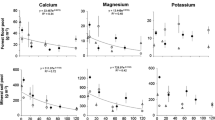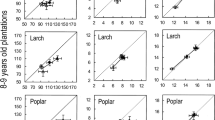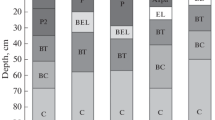Abstract
Long-term changes in concentrations of available Ca in soils of redspruce forests have been documented, but remaining questions aboutthe magnitude and regional extent of these changes have precluded anassessment of the current and future status of soil Ca. To addressthis problem, soil samples were collected in 1992—93from 12 sites in New York, Vermont, New Hampshire, and Maine toprovide additional data necessary to synthesize all availableresearch results on soil Ca in red spruce forests. Sites werechosen to encompass the range of environmental conditionsexperienced by red spruce. Concentrations of exchangeableCa ranged from 2.13 to 21.6 cmolckg−1 in the Oa horizon, and from 0.11 to 0.68cmolc kg−1 in the upper 10 cm of theB horizon. These measurements expanded the range of exchangeable Ca reported in the literature for both horizons in northeastern redspruce forests. Exchangeable Ca was the largest Ca fraction in theforest floor at most sites (92% ofacid-extractableCa), but mineral Ca was the largest fraction at the three sites that also had the highest mineral-matter concentrations. Theprimary factor causing variability in Ca concentrations among siteswas the mineralogy of parent material, but exchangeable concentrationsin the B horizon of all sites were probably reduced by acidicdeposition. Because the majority of Ca in the forest floor isin a readily leachable form, and Ca inputs to the forest floor from the mineral soil and atmospheric deposition have beendecreasing in recent decades, the previously documented decreasesin Ca concentrations in the forest floor over previous decades mayextend into the future.
Similar content being viewed by others
References
Andersen SB (1988) Long-term changes in the acid-base status of forest soils in the Adirondacks of New York. Ph.D. Dissertation. Univ. Pennsylvania, pp 521
Bailey SW, Driscoll CT & Hornbeck JW (1995) Acid-base chemistry and aluminum transport in an acidic watershed and pond in New Hampshire. Biogeochemistry 28: 69–91
Bailey SW, Hornbeck JW, Driscoll CT and Gaudette HE (1996) Calcium inputs and transport in a base-poor forest ecosystem as interpreted by Sr isotopes. Water Resources Research 32: 707–719.
Bailey SW & Hornbeck JW (1992) Lithologic composition and rock weathering potential of forested, glacial-till soils. USDA Forest Service Research Paper NE-662 Northeastern Forest Experiment Station, Radnor, Pennsylvania
Blume LJ, Schumacher BA, Schaffer PW, Cappo KA, Papp M, Van Remortel RD, Coffey DS, Johnson MG & Chaloud DJ (1990) Handbook of methods for acid deposition studies: laboratory analyses for soil chemistry US Environmental Protection Agency. EPA/600/4-90/023 Environmental Monitoring Systems Laboratory, Las Vegas, Nevada
Couture S (1995) Response of the Laflamme Lake watershed, Quebec, to reduced sulphate deposition (1981-1992). Can. J. Fish. Aquat. Sci. 52: 1936–1995
Cronan CS & Grigal DF (1995) Use of calcium/aluminum ratios as indicators of stress in forest ecosystems. J. of Env. Qual. 24: 209–226
Cumming BF, Davey KA, Smol JP & Birks HUB (1994) When did acid-sensitive Adirondack Lakes (New York, USA) begin to acidify and are they still acidifying? Can. J. Fish. Aquat. Sci. 51: 1550–1568
Dingman SL (1981) Elevation: a major influence on the hydrology of New Hampshire and Vermont, USA. Hydrol. Sci. Bul. 26: 399–413
Doll CG, CadyWM, Thompson JB & Billings MP (1961) Centennial geologicmap ofVermont. Vermont Geological Survey, Scale 1:250,000
Driscoll CT, Fuller RD, Santore RC & Lawrence GB (1987) The speciation of ions in acidic solutions. Proceedings of the International Soil Congress, July 1986, Hamburg, West Germany, pp 59–62
Federer CA (1982) Subjectivity in the separation of organic horizons of the forest floor. Soil Sci. Soc. Am. J. 46: 1090–1093
Federer CA (1994) BROOK90, a simulation model for evapotranspiration, soil water and streamflow. Version 3.0 Freeware Computer Program and Documentation, USDA Forest Service, Durham, New Hampshire
Federer CA & Hornbeck JW (1985) The buffer capacity of forest soils in New England. Water Air Soil Pollut. 26: 163–173
Federer CA, Hornbeck JW, Tritton LM, Pierce RS & Smith CT (1989) Long-term depletion of calcium and other nutrients in eastern US forests. Environ. Manag. 13: 593–601
Federer CA, Turcotte DE & Smith CT (1993) The organic fraction-bulk density relationship and the expression of nutrient content in forest soils Can. J. For. Res. 23: 1026–1032
Fernandez IJ & Lawrence GB (1989) A preliminary report on element cycling and the potential effects of atmospheric deposition in a low elevation, commercial northeast spruce-fir ecosystem. Internal Report, USDA-FS Northeastern Forest Experiment Station, Radnor, Pennsylvania
Fisher DW, Isachsen YW & Rickard LV (1971) Geologic Map of New York New York State Museum and Science Service. Number 15, Scale 1:250,000
Friedland AJ, Johnson AH, Siccama TG & Mader DL (1984) Trace metal profiles in the forest floor of New England. Soil Sci. Soc. Am. J. 48: 422–425
Hedin LO, Granat L, Likens GE, Buishand TA, Galloway JN, Butler TJ & Rodhe H (1994) Steep declines in atmospheric base cations in regions of Europe and North America. Nature 367: 351–367
Heimburger CC (1934) Forest-type studies in the Adirondack Region Cornell University Agriculture Experiment Station Memoir 165 Cornell University, Ithaca, New York
Huntington TG & Ryan DF (1988) Soil chemical properties in the spruce-fir zone at Mt. Moosilauke in New Hampshire. In: Proc of the US/FRG research symposium: effects of atmospheric pollutants on the spruce-fir forests of the eastern United States and Federal Republic of Germany. Burlington, Vermont, 18-23 Oct 1987. USDA Forest Service General Technical Report NE-120 Northeastern Forest Experiment Station, Broomall, Pennsylvania, pp 191–198
Johnson AH, Andersen SB & Siccama TG (1994a) Acid rain and soils of the Adirondacks. I. Changes in pH and available calcium. Can. J. For. Res. 24: 193–1984
Johnson AH, Friedland AJ, Miller EK & Siccama TG (1994b) Acid rain and soils of the Adirondacks III Rates of soil acidification in a montane spruce-fir forest at Whiteface Mountain, New York. Can. J. For. Res. 24: 663–669
Johnson DW & Fernandez IJ(1992) Soil mediated effects of atmospheric deposition on eastern US spruce-fir forests. In: Eager C & Adams MB (eds) Ecology and decline of red spruce in the eastern United States. Springer-Verlag, New York, pp 235–270
Joslin JD, Kelly JM & Van Miegroet H (1992) Soil chemistry and nutrition of North American spruce-fir stands: evidence for recent change. J. Environ. Qual. 21: 12–30
Kuhn AJ, Bauch J & Schroeder WH (1995) Monitoring uptake and contents of Mg, Ca and K in Norway spruce as influenced by pH and Al, using microprobe analysis and stable isotope labeling. Plant Soil 168-169: 135–150
Lawrence GB, David MB & Shortle WC (1995) Aluminum mobilization as a mechanism for calcium depletion in organic forest soil horizons. Nature 378: 162–165
Likens GE, Driscoll CT & Buso DC (1996) Long-term effects of acid rain: response and recovery of a forest ecosystem. Science 272: 244–246
Lyons JB, Bothner WA, Moench RH & Thompson JB (1986) Interim geologic map of Maine. Maine Geological Survey, Scale 1:500,000
McLaughlin JW, Fernandez IJ & Richards KJ (1996) Atmospheric deposition to a low-elevation spruce-fir forest, Maine, USA. J. Environ. Qual. 25: 248–259
McLaughlin SB, TjoelkerMB & Roy WX(1993) Acid deposition alters red spruce physiology: laboratory studies support field observations. Can. J. For. Res. 23: 380–386
McNulty SG, Aber JD & Boone RD (1991) Spatial changes in forest floor and foliar chemistry of spruce-fir forests across New England. Biogeochemistry 14: 13–29
Miller EK, Friedland AJ, Arons EA, Mohnen VA, Battles JJ, Panek JA, Kadlecek J & Johnson AH (1993) Atmospheric deposition to forest along an elevational gradient at Whiteface Mountain, NY, USA. Atmos. Environ. 27A:2121–2136
Miller EK, Huntington TG, Johnson AH & Friedland AJ (1992) Aluminum in soil solutions from a subalpine spruce-fir forest at Whiteface Mountain, New York. J. Environ. Qual. 21: 345–352
Mollitor AV & Raynal DJ (1982) Acid precipitation and ionic momements in Adirondack forest soils. Soil Sci. Soc. Am. J. 46: 137–141
NADP [National Atmospheric Deposition Program] (1993) NADP/NTN Annual Data Summary Precipitation Chemistry in the United States 1992. Natural Resource Ecology Laboratory, Colorado State University, Fort Collins, Colorado, pp 480
NAPAP [National Acid Precipitation Assessment Program] (1992) National Acid Precipitation Assessment Program Report to Congress. US Government Printing Office Washington. DC
Ollinger SV, Aber JD, Lovett GM, Millham SE, Lathrop RG & Ellis JM (1993) Aspatialmodel of atmospheric deposition for the northeastern US. Ecological Applications 3: 459–472
Osberg PH, Hussey AM & Boone GM (1985) Bedrock geologic map of Maine. Maine Geological Survey, Scale 1:500,000
Parry SJ (1991) Activation Spectrometry in chemical analysis. In:Winefordner & JD & Kolthoff IM (eds) Chemical analysis, vol. 119. John Wiley and Sons, NY
Reuss LO (1983) Implications of the Ca-Al exchange system for the effect of acid precipitation on soils. J. Environ. Qual. 12: 591–595
Rodhe H, Grennfelt P, Wisniewski J, Agren C, Bengtsson B, et al. (1995) Summary statement from the 5th International Conference on Acidic Deposition Science and Policy. Goteborg, Sweden. Water Air Soil Pollut. 85: 1–14
Ross DS, Bartlett RJ & Magdoff FR (1991) Exchangeable cations and the pH independant distribution of cation exchange capacities in Spodosols of a forested watershed. In:Wright RJ et al. (eds) Plant-soil interactions at low pH. Kluwer Academic Publishers, the Netherlands, pp 81–92
Rustad LE (1988) The biogeochemistry of aluminum in a red spruce forest floor in Maine. Ph.D. Thesis, University of Maine, Orono, Maine, 197 p
Rustad LE & Cronan CS (1995) Biogeochemical controls on aluminum chemistry in the O horizon of a red spruce (Picea rubensSarg.) stand in central Maine, USA. Biogeochemistry 29: 107–129
Rustad LE, Kahl JS, Norton SA & Fernandez IJ (1994) Underestimation of dry deposition by throughfall in mixed northern hardwood forests. J. Hydrol. 162: 319–336
Shortle WC & Bondietti EA (1992) Timing, magnitude and impact of acidic deposition on sensitive forest sites. Water Air Soil Pollut. 61: 253–267
Shortle WC & Smith KT (1988) Aluminum-induced calcium deficiency syndrome in declining red spruce trees. Science 240: 1017–1018
Valmari J (1921) Beitrage sur chemischen bodenanalyse. Acta Forestalia Fennica 20, pp 67
Author information
Authors and Affiliations
Rights and permissions
About this article
Cite this article
LAWRENCE, G.B., DAVID, M.B., BAILEY, S.W. et al. Assessment of soil calcium status in red spruce forests in the northeastern United States. Biogeochemistry 38, 19–39 (1997). https://doi.org/10.1023/A:1005790130253
Issue Date:
DOI: https://doi.org/10.1023/A:1005790130253




